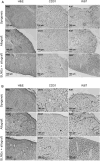Engendering allograft ignorance in a mouse model of allogeneic skin transplantation to the distal hind limb
- PMID: 24509194
- PMCID: PMC4573553
- DOI: 10.1097/SLA.0000000000000572
Engendering allograft ignorance in a mouse model of allogeneic skin transplantation to the distal hind limb
Abstract
Objective: The aim of this study was to demonstrate lymphatic isolation in a model of hind limb lymph node (LN) excision, consisting of ipsilateral popliteal and inguinal LN excision and to evaluate the immunologic response to allogeneic skin transplanted onto this region of lymphatic isolation.
Methods: To study lymphatic flow, C57BL/6 mice underwent lymphadenectomy (n = 5), sham lymphadenectomy (n = 5), or no intervention (n = 5), followed by methylene blue injection. Mice were dissected to determine whether methylene blue traveled to the iliac LN. To study host response to skin transplantation, C57BL/6 mice underwent allogeneic skin transplantation with LN excision (n = 6), allogeneic skin transplantation alone (n = 6), or syngeneic skin transplantation (n = 4). Skin grafts were placed distal to the popliteal fossa and mice were euthanized at day 10. Grafts were stained for endothelial cell and proliferation markers (CD31 and Ki67, respectively). Secondary lymphoid tissues (spleen, ipsilateral axillary LN, and contralateral inguinal LN) were removed and rechallenged with BALB/c alloantigen in vitro with subsequent assay of interferon-γ and interleukin 4 cell expression using ELISPOT technique.
Results: Mice that underwent LN excision had no evidence of methylene blue in the iliac nodes; mice without surgical intervention or with sham LN excision consistently had methylene blue visible in the ipsilateral iliac nodes. Mice treated with allogeneic skin transplantation and LN excision had lower expression of interferon-γ and interleukin 4 in the secondary lymphoid tissues.
Conclusions: Lymph node excision completely interrupts lymphatic flow of the hind limb. This model of lymphatic isolation impairs the ability of the transplant recipient to acutely mount a Th1 or Th2 response to allogeneic skin transplants.
Conflict of interest statement
Disclosure: The authors declare no conflicts of interest.
Figures





References
-
- Brandacher G, Lee WP, Schneeberger S. Minimizing immunosuppression in hand transplantation. Expert Rev Clin Immunol. 2012;8:673–684. - PubMed
-
- Ravindra KV, Ildstad ST. Immunosuppressive protocols and immunological challenges related to hand transplantation. Hand Clin. 2011;27:467–479. - PubMed
-
- Ravindra KV, Wu S, McKinney M, et al. Composite tissue allotransplantation: current challenges. Transplant Proc. 2009;41:3519–3528. - PubMed
Publication types
MeSH terms
Substances
Grants and funding
LinkOut - more resources
Full Text Sources

